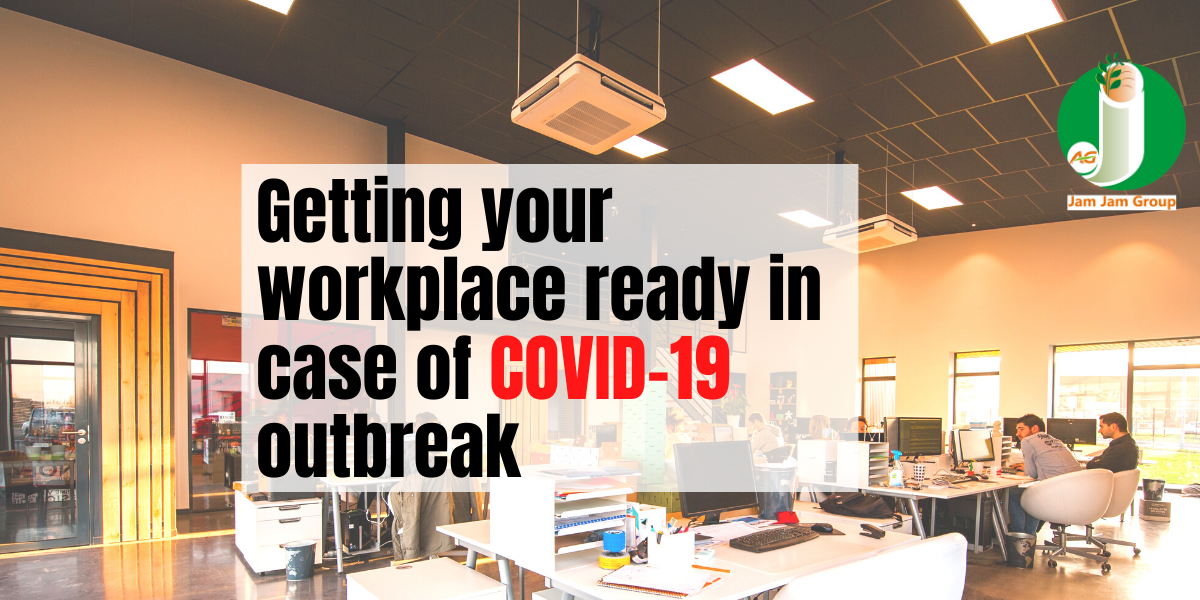
Getting your workplace ready for COVID-19
In December 2019 the outbreak of coronavirus disease started in Hubei Province, China. The outbreak was declared by World Health Organization (WHO) as a Public Health Emergency of International Concern on 30 January 2020.WHO stated there’s a high risk of the 2019 coronavirus disease (COVID-19) spreading to other countries round the world. All sections of our society including businesses and employers – must act to prevent the spread of this disease.
How COVID-19 spreads
People could catch COVID-19 by touching contaminated surfaces or objects – then touching their eyes, nose or mouth. If they’re standing within one meter of an individual with COVID-19 they will catch it by inhaling droplets coughed out or exhaled by them. Risk of great illness rises with age: people over 40 years of ageseem to be more vulnerable than those under 40. People with weakened immune systems and other people with conditions like diabetes, heart and lung disease also are more susceptible to serious illness.
This blog gives advice on:
- Low cost ways to stop the spread of COVID-19 in your workplace
- Ways to manage COVID-19 risks when organizing meetings & events
- Things to think about once you and your employees travel
- Getting your workplace ready just in case COVID-19 arrives in your community
- Low cost ways to stop the spread of COVID-19 in your workplace
Employers should start doing this stuff now. They can already reduce working days and stop or slow the spread of COVID-19 if it arrives at one among your workplaces.
- Maintain your workplaces are clean and hygienic
- Surfaces (e.g. desks and tables) and objects (e.g. telephones, keyboards) need to be wiped with disinfectant regularly.
Promote good respiratory hygiene in the workplace
- Display posters promoting respiratory hygiene. Combine this with other communication
measures like offering guidance from occupational health and safety officers, briefing
at meetings and information on the intranet etc.
- Make sure that face masks and / or paper tissues are available at your workplaces, for those who develop a runny nose or cough at work, alongside closed bins for hygienically disposing of them
- Keep communicating and promoting the message that they need to stay home even if they have just mild symptoms of COVID-19.
- Combine this with other communication channels commonly utilized in your organization or business
- Key considerations to prevent or reduce COVID-19 risks
BEFORE the meeting or event
- Check the recommendation from the authorities within the community where you propose to carry the meeting or event. Follow their advice.
- Develop and agree preparedness decide to prevent infection at your meeting or event.
- Consider whether a face-to-face meeting or event is required
- Could the meeting or event be scaled down in order that fewer people attend?
Develop and agree a response plan just in case someone at the meeting becomes ill with symptoms of COVID-19 (dry cough, fever, malaise). This plan should include at least:
- Identify an area where someone who is feeling unwell or has symptoms are often safely isolated
- Have an idea for a way they will be safely transferred from there to a clinic.
DURING the meeting or event
Provide information or an appointment, preferably both orally and in writing, on COVID-19 and therefore the measures that organizers are taking to form this event safe for participants.
- Build trust. For instance, as an icebreaker, practice ways to mention hello without touching.
- Provide contact details or a health hotline number that participants can involve advice or to give information.
- Display dispensers of alcohol-based hand rub prominently round the venue.
- Things to think about once you and your employees travel
- Before traveling
- Confirm your organization and its employees have the newest information on areas where COVID-19 is spreading.
- Avoid sending employees who could also be at higher risk of great illness (e.g. older employees and people with medical conditions like diabetes, heart and lung disease) to areas where COVID-19 is spreading.
- While traveling:
- Encourage employees to scrub their hands regularly and maintain at least one meter away from people that are coughing or sneezing
- Ensure employees know what to try and who to contact if they feel ill while traveling.
- Make sure that your employees suits instructions from local authorities where they are traveling. If, for instance, they’re told by local authorities to not go somewhere they should do this. Your employees should suits any local restrictions on travel, or large gatherings.
- Once you or your employees return from traveling:
- Employees who have returned from a neighborhood where COVID-19 is spreading should monitor themselves for symptoms for 14 days and take their temperature twice each day.
- If they develop even a light cough or low grade fever (i.e. a temperature of 37.3 C or more) they should occupy home and self-isolate. this suggests avoiding close contact (one meter or nearer) with people , including relations . they ought to also telephone their healthcare provider or the local public health department, giving them details of their recent travel and symptoms.
- Getting your workplace ready just in case COVID-19 arrives in your community
Develop an idea of what to try if someone becomes ill with suspected COVID-19 at one among your workplaces
- Tell your local public health authority you’re developing the plan and seek their input.
- Promote regular teleworking across your organization. If there’s an epidemic of COVID-19 in your community the health authorities may advise people to avoid conveyance and crowded places.
- The plan will help prepare your organization for the likelihood of an epidemic of COVID19 in its workplaces or community. It may even be valid for other health emergencies
- Communicate to your employees and contractors about the plan and confirm they’re aware of what they have to try– or not do – under the plan. Emphasize key points such as the importance of staying faraway from work if they have only only mild symptoms or have had to take simple medications (e.g. paracetamol, ibuprofen) which may mask the symptoms
- Make certain your plan addresses the psychological state and social consequences of a case of COVID-19 within the workplace or within the community and offer information and support.
Remember:
Now is the time to prepare for COVID-19. Simple precautions and planning can make an enormous difference.







